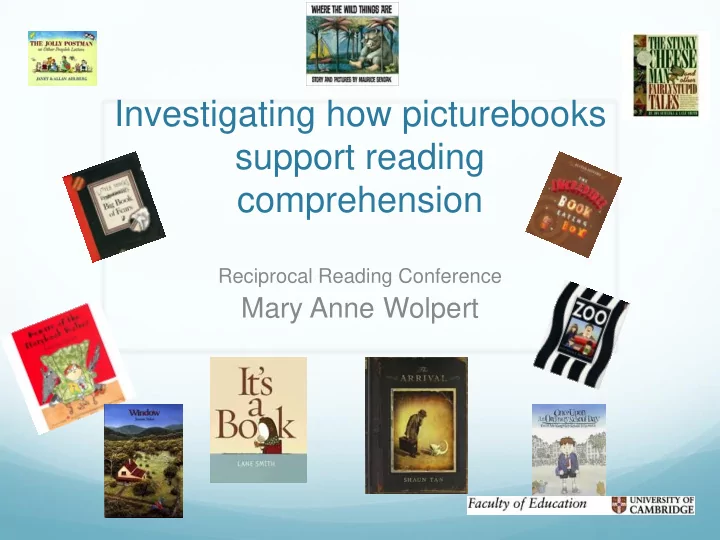

Investigating how picturebooks support reading comprehension Reciprocal Reading Conference Mary Anne Wolpert
‘ In picture books, words and pictures are a fantastic double act, each doing a different job, maybe even telling a different story — but you need both of them to have the whole story. And even the youngest people are expert readers of pictures. So in pictures you can say very complex things, things that it would take an enormous number of words to explain. ’ (Mini Grey, 2006)
The grammar of visual design Kress and Van Leeuwen
Reading Picture Books 1. Relationship between word and image (symmetrical, enhancement, counterpoint, contradiction) 2. Positioning (of text on page, characters in relation to each other, ‘camera’ angles and perspective, white space) 3. Aesthetics (colour and light, line, framing) 4. Intertextual links 5. Text cohesion (pacing, intratextual links, vectors,)
2. Positioning (of text on page, characters in relation to each other, ‘camera’ angles and perspective, white space)
3. Aesthetics (colour and light, line, framing)
4. Intertextual links
5. Text cohesion (pacing, intratextual links, vectors,)
Postmodern Picture Books Words and pictures interact Deliberate boundary breaking Traditional devices/endings resisted – interrupted reading experience, gaps to challenge the reader Use of metafictive Intertextual and intratextual links Irony, parody, playfulness and humour Shift in narrators ’ positions Multilayered, multiple meanings Multimodality Use of font
Research into children’s responses Children Reading Pictures ‘Dipping into the cauldron: A case study of 6 children reading and interpreting a complex picture book.’
Research questions How would bilingual children use the relationship between word and pictures to participate in meaning- making? What links to other texts would they make and how would they fill the gap between text and reader with their own experiences and interests? How would talking at length about a book with peers affect their understanding and engagement?
Analysis Reading word and image: filling in the gap Intertextual links: creating shared worlds Having a voice: the value of talk
The potential of picturebooks Emotional engagement Intellectual challenge The capacity to stimulate and provide ways of demonstrating thinking The potential to access deeper layers of meaning through the interpretation of word and image and the space between The inspiration to talk and push language (Coulthard, 2003)
Recommend
More recommend